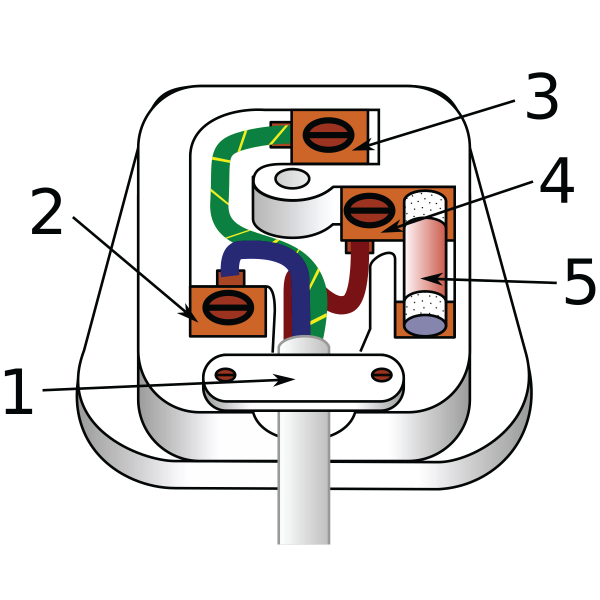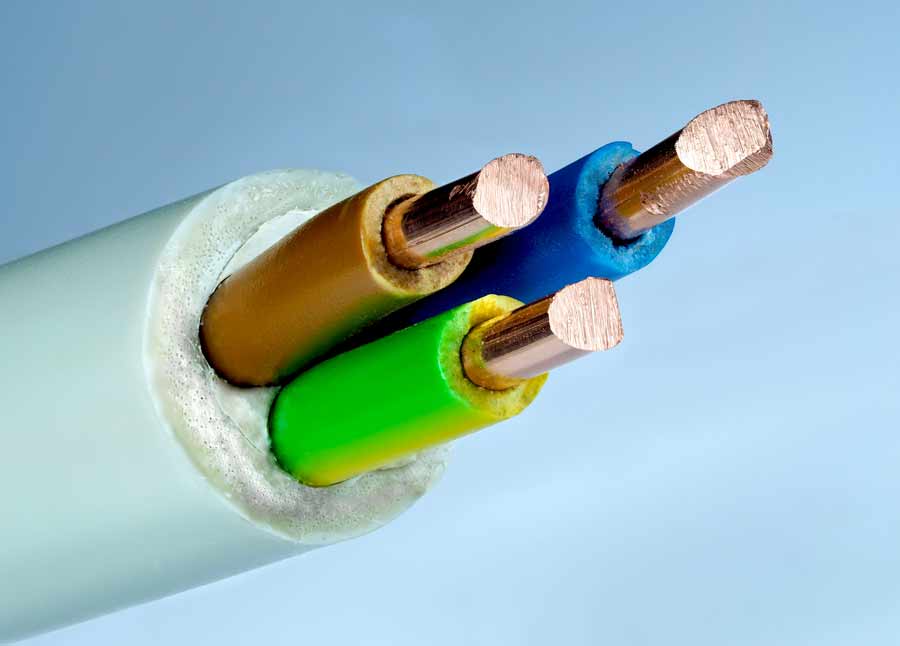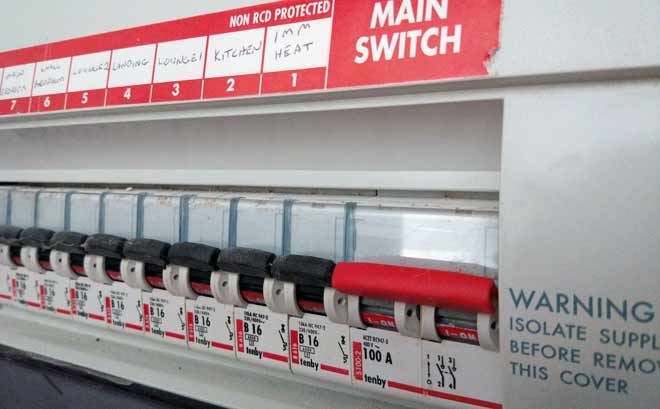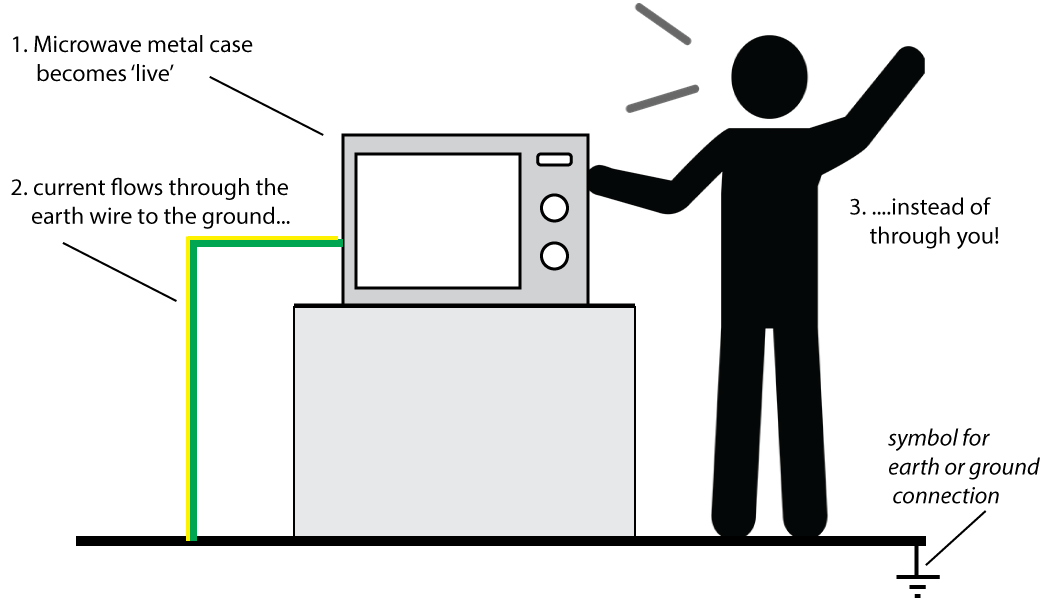Cambridge IGCSE
TOPIC 4A: ELECTRICITY
The electricity in our homes is typically 'mains' electricity and high voltage, typically 110 V or 230 V. This can be extremely dangerous, so all homes and devices have a range of safety features installed, starting with the design of a typical mains plug:
The design and layout of plugs varies widely from country to country, but typically a plug has 2 or 3 'pins'. The picture below is a common internal layout with 3 pins.

Figure 1: A typical mains plug
(Wikimedia commons-Theresa Knott)
As this is an international course, you do not need to learn the layout of one particular country, but it is useful to understand some of the key parts of the plug:
Mains electricity is extremely dangerous as discussed in section 2.5. For this reason, there are many safety features used to try to minimise the risks involved.
In this section, we will take a look at the key safety features used in most countries, and learn how they work.
Electricity in our homes flows through conductors, typically metals such as copper. If we touched the copper, we could get a shock. The most obvious - and simple - preventative measure is to insulate the copper cables with a substance such as plastic. In figure 2, you can see that each individual wire has a coloured insulating coating, and then the three cables are insulated again in an outer white coating.
This insulation also gives protection from water, which as a fluid conductor, you do not want anywhere near the conducting copper.

Figure 2. An insulated mains cable
Petar Milošević C.C licence 3.0
A fuse is a simple, cheap safety device inside many mains plugs. It consists of a thin metal wire, mounted inside a short cylinder as shown in figure 3.

Figure 3. A mains plug fuse
photo AKA, CC-by SA 2.5
The fuse is designed to melt when a specific current passes through it. As we learnt in section 4.2e, all resistors produce heat as a current flows through them. The resistance in a fuse wire is tiny, and does not affect the circuit in any significant way, but the heat produced is enough to melt the thin wires used, as shown in this video.
YouTube - Fuse wire melting (Devdatta Raut)
When the fuse melts, it breaks the circuit and turns the appliance off. Note that it is connected to the live wire and breaks the connection to this wire - the dangerous one! The sequence of events is designed to work as follows:
The fuse used must be chosen carefully to match the appliance. This is because the fuse should always be rated as just above the current needed for the appliance.
For example, a 0.4 A lamp might be accidentally fitted with a 13 A fuse. If the lamp has a sudden surge of 4 A - a potential hazard, the fuse would not burn out, or 'blow'. You would need a lower rated fuse, perhaps 1 A, so that the surge blows the fuse making the device safe.
Typically you can buy 1, 3, 5, 8 and 13 A fuses although many others are possible. In exam questions, you will be given an example list to chose from, as shown here:
Questions:
1. A 2kW hairdryer is connected to the mains supply of 240 V.
a) We know that P = I x V, so:
| I = | P |
| V |
| I = | 2000 |
| 240 |
I= 8.33 A
b) If the hairdryer uses 8.33 A, then an 8 A fuse will blow, as will anything rated lower than 8 A. The next one available above 8.33 A is the 13 A fuse.
A circuit breaker is basically a more modern adaptation to the fuse. They work using electromagnets, which open a switch if the current gets too high, and this breaks the circuit. Many different current ratings are available.
Although the large circuit breaker box used in many homes is expensive, the advantage is that the switches can be easily reset. You do not need to buy a new fuse.

Figure 4. A typical circuit breaker unit
In modern houses, a circuit breaker is a key part of the mains electricity supply, and is a requirement by law in many countries.You do not need to learn about the different types and designs; only a basic understanding of their use is needed and the advantage of a circuit breaker over a fuse system. In addition, you should be able to choose a suitable 'trip rating' for the switch just as you would when selecting a fuse. For example, the large red trip switch in figure 4 will trip if a current larger than 100 A flows through the circuit.
Many microwave ovens have a metal case. Inside the case are the workings of the oven, all connected to the mains supply through the live wire. However, what would happen if the live wire accidentally came loose and touched the metal casing?
In this scenario, you could get a dangerous electric shock from the 'live' metal casing. A current would flow through you, down to the ground.
This is where the earth wire comes in to play. The earth wire is connected to the metal casing of the appliance, and leads into the ground. As it is made of copper, it is a much easier route for current to flow (a MUCH lower resistance than you) and the current flows down this route - you are saved from a nasty shock!
In addition, the sudden surge of current down the earth wire would blow the fuse, and cut off the microwave oven.

Figure 5. How the earth wire works
Note that in real life, the earth wire is inside the mains cable, not on its own as shown here. You may see these green and yellow earth wires around at home, connected to water pipes and electrical appliances for additional safety.
Some devices do not need an earth wire. A plastic vacuum cleaner and a plastic phone charger do not have a metal case, so there is nowhere to connect the earth wire, and no chance of an electric shock from the plastic case. Devices like this are called 'double insulated', because the wires themselves are insulated, as well as another insulating barrier or case around the connections to prevent a shock.
The symbol for a double insulated device is 2 squares, one inside the other:

Figure 6. The symbol for a double insulated device
Devices like plastic phone chargers do not need an earth wire, and this is why they are often found with only 2 metal pins.
Some metal devices are still double insulated, because the live connection has a second insulating barrier between the wires and the casing.
Questions:
2. An 800 W microwave oven is connected to a 230 V a.c. mains supply.
a) We know that P = I x V, so:
| I = | P |
| V |
| I = | 800 |
| 230 |
I = 3.48 A (or 3.5 A)
b) The next available fuse above 3.5 A is the 5 A fuse.
c) The earth wire should be connected to the metal casing of the oven.
d) The following points should be included in this answer:
e) The following points should be included in this answer:
For this course, you should be able to state the main hazards that frequently occur in homes and offices where mains electricity is used. These include:
(a) damaged insulation - leading to potential electric shocks.
(b) overheating cables - too much current heats up the wires and could potentially cause a fire.
(c) damp conditions - water near to mains plugs and devices could lead to an electric shock.
(d) excess current from overloading of plugs,
extension leads, single and multiple sockets - this again leads to overheating and potential fires.
Now test your understanding using this quick quiz on electrical safety: